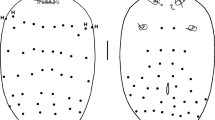Abstract
Trinidad and Tobago, a neotropical country, has 38 reported chigger species. Of these species, 18 were parasitizing bats. Here, we describe a new genus and species parasitizing a ghost-faced bat in this country.





Similar content being viewed by others
References
Barnard, K., Krasnov, B. R., Goff, L., & Matthee, S. (2015). Infracommunity dynamics of chiggers (Trombiculidae) parasitic on a rodent. Parasitology, 142(13), 1605–1611.
Brennan, J. M. (1967). New records of chiggers from the West Indies. Studies on the Fauna of Curaçao and other Caribbean Islands, 34, 146–156.
Brennan, J. M., & Jones, E. K. (1960). Chiggers of Trinidad, BWI (Acarina: Trombiculidae). Acarologia, 2, 493–540.
Grandjean, F. (1935). Les poils et les organes sensitifs portés par les pattes et le palpe chez les oribates. Bulletin de la Société Zoologique de France, 60, 6–39.
Grandjean, F. (1939). Les segments postlarvaires de l’hysterosoma chez les oribates (Acariens). Bulletin de la Société Zoologique de France, 64, 273–284.
Grandjean, F. (1947). L’origine pileuse des mors et la chaetotaxie de la mandibule chez les Acariens actinochitineux. Comptes Rendus Hebdomadaires des séances de l’Académie des Sciences, 224, 1251–1254.
Jacinavicius, F. C., Bassini-Silva, R., Amorim, M., Gazêta, G. S., Siqueira, L. R., Welbourn, C., et al. (2018). Description of Parasecia fernandae sp. n. (Trombidiformes: Trombiculidae) and new records of chiggers from rodents in Rio de Janeiro State. Brazil. Acarina, 26, 205–211.
Jacinavicius, F. C., Bassini-Silva, R., Oliveira, G. M. B., Horta, M. C., Welbourn, C., Ochoa, R., et al. (2019). Description of Pseudoschoengastia petrolinensis n. sp. (Trombidiformes: Trombiculidae), and new records of chiggers from northeastern Brazil. International Journal of Acarology, 45, 227–232.
Jacinavicius, F. C., Bassini-Silva, R., Huang-Bastos, M., Horta, M. C., & Barros-Battesti, D. M. (2020). New species of chiggers (Trombidiformes: Trombiculidae and Leeuwenhoekiidae) from the conservation unit Parque Nacional da Serra das Confusões. Brazil. Journal of Medical Entomology, 58(1), 286–297.
Kethley, J. B. (1990). Acarina: Prostigmata (Actinedida). In D. L. Dindal (Ed.), Soil Biology Guide (pp. 667–756). New York: John Wiley & Sons.
Loomis, R. B., & Webb, J. P. (1969). A new species of Speleocola (Acarina: Trombicuhdae), off a bat, Pizonyx vivesi, from Baja California, Mexico. Bulletin of the Southern California Academy of Sciences, 68, 36–42.
Moniuszko, H., Felska, M., & Mąkol, J. (2018). Evidence for co-invasion events: different chigger species (Actinotrichida, Trombidioidea: Trombiculidae) share a host. Experimental and Applied Acarology, 76, 29–39.
Vercammen-Grandjean, P. H. (1968). Revision of the genus Myotrombicula Womersley and Heaslip, 1943 (Trombiculidae: Acarina). Acarologia, 10(1), 65–68.
Webb, J. P., & Loomis, R. B. (1971). Trombiculid mites of the genus Microtrombicula (Acarina) from Costa Rica. Contributions in Science, 207, 1–15.
Acknowledgements
To Gabrielle R. de Andrade and Maria C. F. do Rosário for technical contribution, Debra Creel (SEL-USDA), Andrew Ulsamer (SEL-USDA), Armando Rosario-Lebron (APHIS-USDA), the Smithsonian Natural History Museum and National Agricultural Library (NAL-USDA) for their help with references and technical support. This work was supported by Conselho Nacional de Desenvolvimento Científico e Tecnológico (CNPq no. 440639/2015-8 to DMB-B; 377976/2014-8 to FCJ) and Fundação de Amparo à Pesquisa do Estado de São Paulo (FAPESP no. 2017/01416-7 and 2018/24667-8 to RB-S, and 2019/19853-0 to FCJ). This study was financed in part by the Coordenação de Aperfeiçoamento de Pessoal de Nível Superior - Brasil (CAPES) - Finance Code 001. Mention of trade names or commercial products in this publication is solely for the purpose of providing specific information and does not imply recommendation or endorsement by the USDA; USDA is an equal opportunity provider and employer.
Author contributions
All authors contributed to the study conception and design. Data collection and analysis were performed by RB-S, MH-B and FCJ. Type examination and preparation of the drawings performed by RB-S and FCJ. Literature survey and provision of sources in order to examine the material were provided by RO and CW. Leadership responsibility for this research activity planning, execution and acquisition of the financial support were performed by DMB-B. The first draft of the manuscript was written by RB-S and all authors commented on previous versions of the manuscript. All authors read and approved the final manuscript.
Conflict of interest
The authors declare that they have no conflict of interest.
Author information
Authors and Affiliations
Corresponding author
Additional information
Publisher's Note
Springer Nature remains neutral with regard to jurisdictional claims in published maps and institutional affiliations.
Rights and permissions
About this article
Cite this article
Bassini-Silva, R., Huang-Bastos, M., Welbourn, C. et al. Batmanacarus robini, n. gen., n. sp. (Trombidiformes: Trombiculidae) collected parasitizing a ghost-faced bat (Chiroptera: Mormoopidae) from a cave in Trinidad and Tobago. Syst Parasitol 98, 277–283 (2021). https://doi.org/10.1007/s11230-021-09976-2
Received:
Accepted:
Published:
Issue Date:
DOI: https://doi.org/10.1007/s11230-021-09976-2




